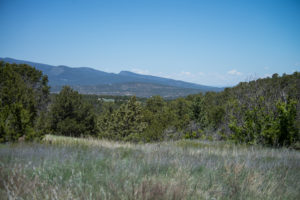Rancho Verde Story: Part 9 – Native Flora

Rancho Verde is a residential mountain community nestled between the Sandia and Manzano (apple tree) Mountains of central New Mexico (NM).
Despite the minimal annual rainfall plant life in New Mexico is pleasantly abundant and diverse. There are nearly 1,000 different types of plants which have been identified in this geographic area alone. These are comprised of 100 families, 450 genera, and almost 800 native species. Just over 100 species which are considered exotic and 30+ additional native taxa. The exotic species make up almost 12% of NM’s flora and are broadly divided into two categories, introduced species and escaped species (generally from gardens). Examples of introduced species are European and Eurasian pasture grasses (which have gone on to become “naturalized” within NM’s flora) and some legumes which were introduced to reclaim damaged land as well as to provide forage for livestock. Fortunately, only a few of the non-native species have developed into noxious weeds and tend to be found in canyons or lining roads.
Today, there is relatively little botanical research being conducted in NM, likely due to the broader array of subjects available to university students in our modern era and, no doubt, also due to the arduous physical nature of field research in this rugged and arid geographical region. An early, and significant, contributor to the store of knowledge on the area’s flora was John Bigelow, a surgeon and naturalist, who accompanied the 1853 Whipple Expedition, led by Lieutenant Whipple. This expedition’s primary purpose was to survey a potential trans-continental rail road route across the western US. The Whipple Expedition spent a month in Albuquerque in October of 1853 to rest and recuperate which gave John Bigelow the opportunity to explore the Sandia Mountains and Tijeras Canyon. During these forays he collected diverse samples of the flora which he subsequently delivered to Harvard University for precise identification and classification. Interestingly, John Bigelow was not particularly physically healthy (although he lived to be 74) but his zest for botanical research enabled him to investigate significant areas in his botanical research in very difficult terrain. Whipple and Bigelow became close colleagues and would work together again in 1860 on an Army Corps of Engineers project with Bigelow functioning as the meteorologist. Whipple would subsequently be killed in the Civil War. Much of today’s base knowledge of NM’s flora can be traced to his early research with a long list of flora bearing Bidelow’s name including 17 in California alone.
In broad terms, the flora can be characterized in ascending order of elevation and precipitation as follows: 1) foothills scrub found at lower elevations 2) piñon-juniper woodland 3) ponderosa pine forests 4) mixed conifer forests and 5) sub-alpine on the highest peaks. The Rancho Verde community is located between 6,800 and 7,400 feet above sea level and one of the distinctive characteristics is the abundant piñon-juniper woodland mixed with sizeable ponderosa trees. The two tree types provide privacy between neighbours and shade on hot summer days. Rancho Verde’s dedicated open space ensures the community will never be overcrowded and are punctuated with notable grasses including sideoats grama and bristly wolftail.
Rancho Verde offers 1+ acre view lots that are fully serviced and platted, with sweeping open vistas of the Sandia, Manzano and Manzanita Mountains with their spectacular sunrises and sunsets. Natural trails throughout Rancho Verde’s 245 acres of permanent Open Space provide a fascinating way to discover and connect with NM’s East Mountain flora.
 /
/  /
/